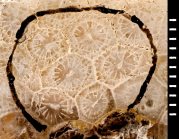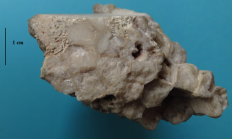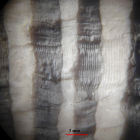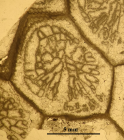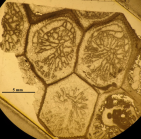WoRMS taxon details
Amphiastrea Étallon, 1859 †
1440277 (urn:lsid:marinespecies.org:taxname:1440277)
accepted
Genus
Amphiastraea Étallon, 1859 † · unaccepted > misspelling - incorrect subsequent spelling
Diplocoenia Duncan, 1868 † · unaccepted > junior homonym
Diplothecastraea Duncan, 1884 † · unaccepted > junior subjective synonym
- Species Amphiastrea basaltiformis Étallon, 1859 †
- Species Amphiastrea cylindrica Ogilvie, 1897 †
- Species Amphiastrea falax (Eliášová, 1975) †
- Species Amphiastrea gracilis Koby, 1888 †
- Species Amphiastrea hiraigaensis Eguchi, 1851 †
- Species Amphiastrea kamoensis Eguchi, 1951 †
- Species Amphiastrea monitor (Duncan, 1868) †
- Species Amphiastrea piriformis Gregory, 1900 †
- Species Amphiastrea yabei Eguchi, 1951 †
- Species Amphiastrea rarauensis Morycowa, 1971 † accepted as Metaulastrea rarauensis (Morycowa, 1971) † (unaccepted > superseded combination)
marine, fresh, terrestrial
fossil only
Étallon, M.A. (1859). Études paléontologiques sur la Haut-Jura: Rayonnés du Corallien. <em>Mémoires de la Société d'Emulation du Département du Doubs, Troisième Série.</em> 3: 401-553. [details]
Description Massive cerioid colony. Strictly polygonal calices. Pachytheca with a median line (the wall is not really shared between...
Description Massive cerioid colony. Strictly polygonal calices. Pachytheca with a median line (the wall is not really shared between two adjacent corallites as usually in Scleractinia; for this reason it is sometimes described as phaceloid). Marginarium and Taschenknospung present. Radial elements are smooth with irregular sharp granules, mostly free septa, occasionnaly joined, flexuous to straight. Septa made of small numerous simple trabecules in weakly inclined series. Lonsdaleoid septa present. Septal apparatus with a strong bilateral symmetry. A septum thicker than others at least in some species. Eccentric axial pit. Peripheral steeply inclined vesicular dissepiments. Cellular central dissepiments controversial. Striated epitheca not necessarily complete present around each corallite. No peritheca, no synapticula, no palus, no columella [details]
Hoeksema, B. W.; Cairns, S. (2024). World List of Scleractinia. Amphiastrea Étallon, 1859 †. Accessed through: World Register of Marine Species at: https://www.marinespecies.org/aphia.php?p=taxdetails&id=1440277 on 2024-07-16
Date
action
by
![]() The webpage text is licensed under a Creative Commons Attribution 4.0 License
The webpage text is licensed under a Creative Commons Attribution 4.0 License
original description
Étallon, M.A. (1859). Études paléontologiques sur la Haut-Jura: Rayonnés du Corallien. <em>Mémoires de la Société d'Emulation du Département du Doubs, Troisième Série.</em> 3: 401-553. [details]
original description (of Diplothecastraea Duncan, 1884 †) Duncan PM (1884) A revision of the families and genera of the sclerodermic Zoantharia, Ed. & H., or Madreporaria (M. Rugosa excepted). Journal of the Linnean Society of London, 18: 1-204. [details]
original description (of Diplocoenia Duncan, 1868 †) Duncan PM. (1868). On the fossil corals (Madreporaria) of the West-Indian Islands. Part IV. Conclusions. <em>Quarterly Journal of the Geological Society of London.</em> 24: 9-33, pls. 1-2. [details]
basis of record Baron-Szabo R, González-León C. (1999). Lower Cretaceous corals and stratigraphy of the Bisbee Group (Cerro de Oro and Lampazos areas), Sonora, Mexico. <em>Cretaceous Research.</em> 20 (4): 465-497., available online at https://doi.org/10.1006/cres.1999.0159 [details]
additional source Kołodziej B. (2003). Scleractinian corals of suborders Pachythecaliina and Rhipidogyrina: discussion on similarities and description of species from Stramberk-type limestones, Polish Outer Carpathians. <em>Annales Societatis Geologorum Poloniae.</em> 73(3): 193-217. [details]
additional source Kolodziej, B.; Ivanov, M.; Idakieva, V. (2012). Prolific development of pachythecaliines in Late Barremian, Bulgaria: coral taxonomy and sedimentary environment. <em>Annales Societatis Geologorum Poloniae.</em> 82(4): 291-330. [details]
original description (of Diplothecastraea Duncan, 1884 †) Duncan PM (1884) A revision of the families and genera of the sclerodermic Zoantharia, Ed. & H., or Madreporaria (M. Rugosa excepted). Journal of the Linnean Society of London, 18: 1-204. [details]
original description (of Diplocoenia Duncan, 1868 †) Duncan PM. (1868). On the fossil corals (Madreporaria) of the West-Indian Islands. Part IV. Conclusions. <em>Quarterly Journal of the Geological Society of London.</em> 24: 9-33, pls. 1-2. [details]
basis of record Baron-Szabo R, González-León C. (1999). Lower Cretaceous corals and stratigraphy of the Bisbee Group (Cerro de Oro and Lampazos areas), Sonora, Mexico. <em>Cretaceous Research.</em> 20 (4): 465-497., available online at https://doi.org/10.1006/cres.1999.0159 [details]
additional source Kołodziej B. (2003). Scleractinian corals of suborders Pachythecaliina and Rhipidogyrina: discussion on similarities and description of species from Stramberk-type limestones, Polish Outer Carpathians. <em>Annales Societatis Geologorum Poloniae.</em> 73(3): 193-217. [details]
additional source Kolodziej, B.; Ivanov, M.; Idakieva, V. (2012). Prolific development of pachythecaliines in Late Barremian, Bulgaria: coral taxonomy and sedimentary environment. <em>Annales Societatis Geologorum Poloniae.</em> 82(4): 291-330. [details]
 Present
Present  Inaccurate
Inaccurate  Introduced: alien
Introduced: alien  Containing type locality
Containing type locality
From editor or global species database
Comparison Oyonnaxastraea has a thicker wall and an axially thickened major septum but could range in the variability of Amphiastrea. Acanthogyra shows strong granules on lateral faces of septa and a septal budding. Heterastraea has large teeth on inner-distal edge of septa. See also Connectastrea. [details]Description Massive cerioid colony. Strictly polygonal calices. Pachytheca with a median line (the wall is not really shared between two adjacent corallites as usually in Scleractinia; for this reason it is sometimes described as phaceloid). Marginarium and Taschenknospung present. Radial elements are smooth with irregular sharp granules, mostly free septa, occasionnaly joined, flexuous to straight. Septa made of small numerous simple trabecules in weakly inclined series. Lonsdaleoid septa present. Septal apparatus with a strong bilateral symmetry. A septum thicker than others at least in some species. Eccentric axial pit. Peripheral steeply inclined vesicular dissepiments. Cellular central dissepiments controversial. Striated epitheca not necessarily complete present around each corallite. No peritheca, no synapticula, no palus, no columella [details]
Remark 12 Jurassic and 16 Cretaceous nominal species. Amphiastrea valoniensis from the Hettangian does not belong to Amphiastrea. See Eliasova 1975, Kolodziej 1995, 2003 for complementary illustrations. [details]
From editor or global species database
